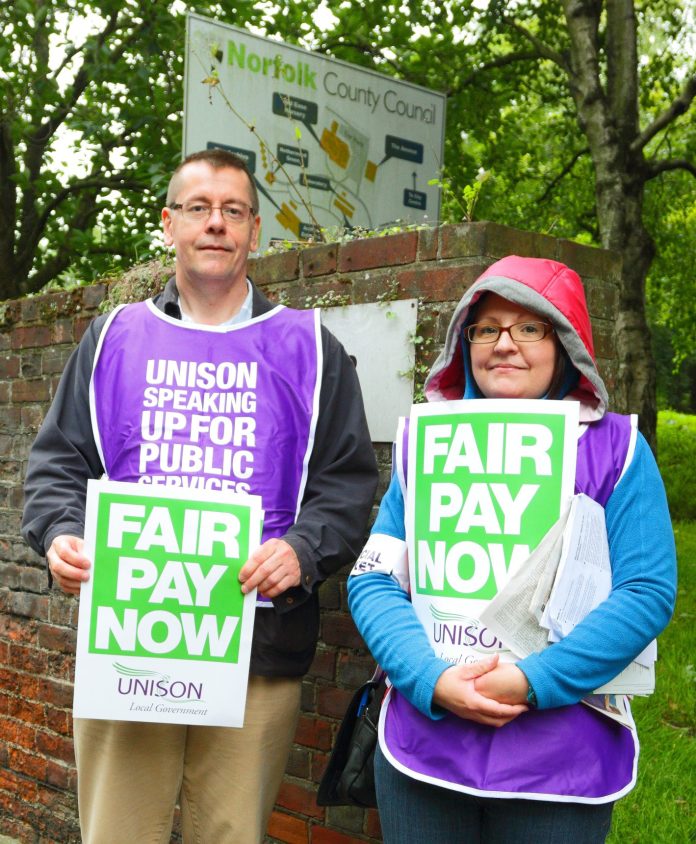Mark Evans, Angie Waller, Hugo Pierre, Unison local government service group executive, personal capacity
Many trade unions have been and will be taking industrial action this autumn. However, based on the outcome of the pay consultation ballot, Unison local government workers will not be joining them in a national strike this year. The vote was 63.5% to accept and 36.5% to reject.
This result poses the question: are Unison members less militant than RMT and Aslef rail workers, CWU telecoms and postal workers, and other trade union members taking strike action over pay? Is it the case that Unison members are better off, and do not need pay awards matching inflation?
The answer is there is little difference between Unison and other trade union members that have been striking for better pay and to protect terms and conditions. Unison local government members have suffered on average a 27% cut in the value of our pay since 2010. Before the cost-of-living crisis hit us, over 60% of our local government members were struggling to pay their bills. We are all working harder for less, so our members desperately need an actual pay rise.
So why did members vote to accept a pay award that represents another pay cut for all, and for many a significant drop in the value of our pay?
Firstly, the pay claim was set far too low, and Unison Socialist Party members stated this at the time. The claim was for £2,000 or matching inflation, whichever was higher.
The offer from the employers was for £1,925. It should be noted that this was a significant improvement on pay offers in previous years, and amounted to just over 10% for the very lowest paid. But for those further up the pay scale, this in percentage terms amounted to less and less. So, another significant pay cut for many.
The other problem is the pay offer is not fully funded. We could now see councils coming for job cuts to cover the cost of the pay deal, leaving branches to be picked off one by one with no national fight.
The significant difference between the striking unions and Unison in local government is leadership. The rail and CWU leaderships recommended action and their members had confidence in their trade union leadership to lead and organise strike action.
In the case of Unison’s reps on the National Joint Council, which has responsibility for pay, they decided not to make a recommendation regarding the final offer from the employer on whether to accept or reject. Most local government branches followed this lead and did not make a recommendation. We think that members concluded from this that their branch and Unison did not want to fight on pay. Little wonder then that they voted to take what was on offer, even if for most, if not all members, they would be worse off as a result!
There is clear proof that this was the case. Where branches – invariably with Socialist Party members or other lefts in their leaderships – recommended rejection of the pay offer and campaigned for it, they achieved significant majorities to reject, the mirror opposite of branches that did not make a recommendation.
How otherwise can it be explained that Blaenau Gwent voted 82% to accept, that Swansea branch voted 74% to accept, but Carmarthenshire County branch voted 82% to reject and Cardiff 63% to reject? How was it that branches like Knowsley and Hounslow, led by Socialist Party members, secured high turnouts (73% and 50%) with reject votes of 83% and 93%?
It is because the latter campaigned to reject. These are branches which have tenaciously fought cuts and mobilised members to defend their interests. Members have the confidence and trust in the leadership of these branches, built through taking action and being honest with members, informing them of the need to take strike action to win pay increases.
The water is not different in Carmarthenshire, Knowsley or Hounslow to the branches that voted to accept. Where resolute and determined leadership is given, members in Unison will be prepared to take action. If the branches that recommended rejection and campaigned for this had been repeated across the union, we would now be preparing to ballot for taking strike action.
It is true that there is an understandable feeling amongst some members of resignation that Unison will never take action over pay, because of previous failures to take action or sustain it under the leadership of the right wing. Christine McAnea, general secretary of Unison, has spoken of the need for branches to be strike-ready, but before and during this ballot there was little help for local government branches in this regard.
For the last year, for the first time in Unison’s history, we have a left-led national executive (NEC), led by the ‘Time for Real Change’ group. However, they themselves failed to call on members to reject the offer! This group, led by Labour Party lefts, the Socialist Workers Party and Socialist Alternative, have been tested and found wanting.
We are now waiting on the outcome of the Unite and GMB consultative ballots. If two unions accept the offer, it will be imposed. Given that Unison has 348,000 members covered by the pay deal, way more than any other union, its national leadership had the duty to give a clear lead – and failed.







